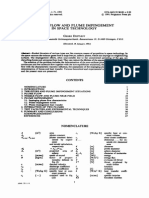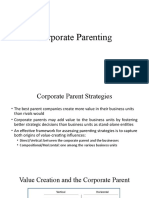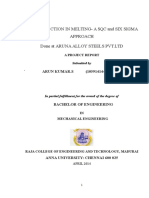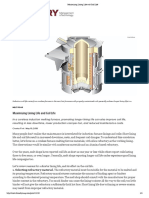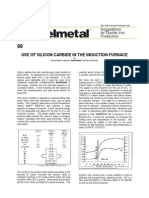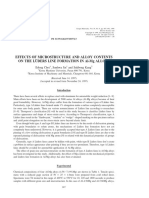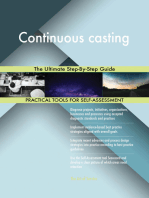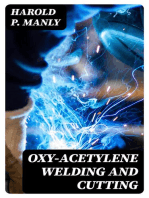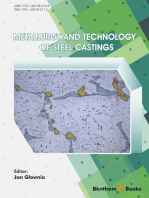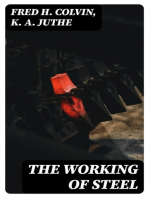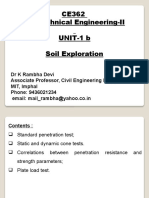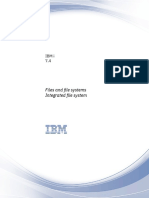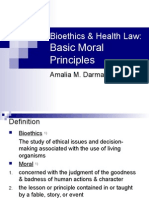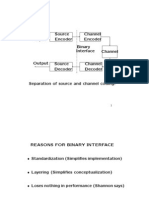Introduction To Brazing V3 PDF
Introduction To Brazing V3 PDF
Uploaded by
Marcelo GuerraCopyright:
Available Formats
Introduction To Brazing V3 PDF
Introduction To Brazing V3 PDF
Uploaded by
Marcelo GuerraOriginal Title
Copyright
Available Formats
Share this document
Did you find this document useful?
Is this content inappropriate?
Copyright:
Available Formats
Introduction To Brazing V3 PDF
Introduction To Brazing V3 PDF
Uploaded by
Marcelo GuerraCopyright:
Available Formats
An Introduction to Brazing
Fundamentals Materials Processing
Sulzer Metco
Issue 3 August 2011
2/24 Issued: August 2011 An Introduction to Brazing
Sulzer Metco
Contents Contents
Fundamentals . . . . . . . . . . . . . . . . . . . . . . . . . . . . . . . . . . . . . . . . . . . . . . . . . . . . . . . . . . . . . . . . . . . . . . . . . . . . . . 3
What Is Brazing? . . . . . . . . . . . . . . . . . . . . . . . . . . . . . . . . . . . . . . . . . . . . . . . . . . . . . . . . . . . . . . . . . . . . . 3
How Is Soldering Different From Brazing? . . . . . . . . . . . . . . . . . . . . . . . . . . . . . . . . . . . . . . . . . . . . . . . . . . 3
How is Brazing Different From Welding? . . . . . . . . . . . . . . . . . . . . . . . . . . . . . . . . . . . . . . . . . . . . . . . . . . . 3
Why Braze? . . . . . . . . . . . . . . . . . . . . . . . . . . . . . . . . . . . . . . . . . . . . . . . . . . . . . . . . . . . . . . . . . . . . . . . . . 3
Considerations for Brazing Success . . . . . . . . . . . . . . . . . . . . . . . . . . . . . . . . . . . . . . . . . . . . . . . . . . . . . . 3
Heat Sources for Brazing . . . . . . . . . . . . . . . . . . . . . . . . . . . . . . . . . . . . . . . . . . . . . . . . . . . . . . . . . . . . . . . 4
Braze Filler Metals . . . . . . . . . . . . . . . . . . . . . . . . . . . . . . . . . . . . . . . . . . . . . . . . . . . . . . . . . . . . . . . . . . . . . . . . . . 5
Braze Filler Metal Base Materials . . . . . . . . . . . . . . . . . . . . . . . . . . . . . . . . . . . . . . . . . . . . . . . . . . . . . . . . . 5
Braze Filler Metal Alloying Elements . . . . . . . . . . . . . . . . . . . . . . . . . . . . . . . . . . . . . . . . . . . . . . . . . . . . . . . 6
Typical Brazing Temperature Ranges for Various Filler Metals . . . . . . . . . . . . . . . . . . . . . . . . . . . . . . . . . . . 6
Available Forms of Braze Filler Metals . . . . . . . . . . . . . . . . . . . . . . . . . . . . . . . . . . . . . . . . . . . . . . . . . . . . . 7
Braze Filler Metal Application by Base Material . . . . . . . . . . . . . . . . . . . . . . . . . . . . . . . . . . . . . . . . . . . . . . 8
Braze Joint Design . . . . . . . . . . . . . . . . . . . . . . . . . . . . . . . . . . . . . . . . . . . . . . . . . . . . . . . . . . . . . . . . . . . . . . . . . . 9
Joint Properties . . . . . . . . . . . . . . . . . . . . . . . . . . . . . . . . . . . . . . . . . . . . . . . . . . . . . . . . . . . . . . . . . . . . . . 9
Calculating the Length of Lap For Flat Joints . . . . . . . . . . . . . . . . . . . . . . . . . . . . . . . . . . . . . . . . . . . . . . . . 9
Joint Configurations . . . . . . . . . . . . . . . . . . . . . . . . . . . . . . . . . . . . . . . . . . . . . . . . . . . . . . . . . . . . . . . . . . 10
Brazing . . . . . . . . . . . . . . . . . . . . . . . . . . . . . . . . . . . . . . . . . . . . . . . . . . . . . . . . . . . . . . . . . . . . . . . . . . . . . . . . . . 11
Capillary Braze Action . . . . . . . . . . . . . . . . . . . . . . . . . . . . . . . . . . . . . . . . . . . . . . . . . . . . . . . . . . . . . . . . 11
Wetting in Braze Joints . . . . . . . . . . . . . . . . . . . . . . . . . . . . . . . . . . . . . . . . . . . . . . . . . . . . . . . . . . . . . . . 11
Typical Heating and Cooling Cycle for Furnace Brazing . . . . . . . . . . . . . . . . . . . . . . . . . . . . . . . . . . . . . . . 12
Vapor Pressure Curves for Vacuum Brazing . . . . . . . . . . . . . . . . . . . . . . . . . . . . . . . . . . . . . . . . . . . . . . . . 13
Braze Joint Morphology . . . . . . . . . . . . . . . . . . . . . . . . . . . . . . . . . . . . . . . . . . . . . . . . . . . . . . . . . . . . . . . 14
Supplementary Process Elements . . . . . . . . . . . . . . . . . . . . . . . . . . . . . . . . . . . . . . . . . . . . . . . . . . . . . . . . . . . . . 15
Braze Procedure . . . . . . . . . . . . . . . . . . . . . . . . . . . . . . . . . . . . . . . . . . . . . . . . . . . . . . . . . . . . . . . . . . . . 15
Inspection . . . . . . . . . . . . . . . . . . . . . . . . . . . . . . . . . . . . . . . . . . . . . . . . . . . . . . . . . . . . . . . . . . . . . . . . . 15
Brazing Aids . . . . . . . . . . . . . . . . . . . . . . . . . . . . . . . . . . . . . . . . . . . . . . . . . . . . . . . . . . . . . . . . . . . . . . . 15
Safety . . . . . . . . . . . . . . . . . . . . . . . . . . . . . . . . . . . . . . . . . . . . . . . . . . . . . . . . . . . . . . . . . . . . . . . . . . . . 15
Brazing Tips . . . . . . . . . . . . . . . . . . . . . . . . . . . . . . . . . . . . . . . . . . . . . . . . . . . . . . . . . . . . . . . . . . . . . . . . . . . . . . 16
Glossary of Brazing Terms . . . . . . . . . . . . . . . . . . . . . . . . . . . . . . . . . . . . . . . . . . . . . . . . . . . . . . . . . . . . . . . . . . . 18
3/24 Issued: August 2011 An Introduction to Brazing
Sulzer Metco
Fundamentals
Considerations for Brazing Success
What Is Brazing?
Brazing is a joining process wherein metals are bonded
together using a filler metal with a melting (liquidus) tem-
perature greater than 450 C (840 F), but lower than
the melting temperature of the base metal. Filler metals
are generally alloys of silver (Ag), aluminum (Al), gold
(Au), copper (Cu), cobalt (Co) or nickel (Ni).
How Is Soldering Different From Brazing?
Soldering is a joining process wherein metals are
bonded together using a non-ferrous filler metal with a
melting (liquidus) temperature lower than 450 C (840
F). Whenever the filler metal liquidus is greater than
450 C (840 F), the joining process is considered to be
a brazing process rather than a soldering process.
How is Brazing Different From Welding?
Welding is a joining process wherein metallic compo-
nents are joined through fusion (melting) or recrystal-
lization of the base metal by applying heat, pressure or
both. This process differs from brazing, where only the
filler metal melts during processing.
Why Braze?
Components can be batch processed
Brazing is production and cost efficient
Component distortion is minimized or eliminated
Base metal dilution is low
Process thermal cycles are predictable
Joining of dissimilar materials can be achieved
Thin-to-Thin or Thin-to-Thick members can be joined
Small and wide gap sizes can be filled
Specialized labor is not required
Fundamentals
Braze Metal Considerations
- Strength
- Coefficient of Expansion
- Potential Metallurgical
Reactions
- Melting Point
- Service Conditions
Desired Joint Properties
- Strength
- Ductility
- Toughness
- Corrosion Resistance
- Service Temperature
- Joint Configuration
- Joint Gap Size
Pre-Braze Considerations
- Cleaning
- Plating
- Braze Alloy Application
Method
Braze Cycle Considerations
- Atmosphere Selection
- Selection of Heat Source
- Ramp Up Rates
- Hold Time and Temperatures
- Time At Temperature
- Cool Down Rates
Post Braze Considerations
- Diffusion Cycle
- Solutioning / Hardening
- Post Machining Operations
Braze Alloy Selection
- Braze Range
- Flow / Wettability
- Self-Fluxing
- Grain Structure
- Remelt Temperature
4/24 Issued: August 2011 An Introduction to Brazing
Sulzer Metco
Fundamentals
Heat Sources for Brazing
Torch Brazing
A heating source supplied by a fuel gas flame. Gases
include acetylene, hydrogen or propane. A typical ap-
plication is to braze a tube into a fitting using copper or
silver brazing filler metals.
Induction Brazing
Electric coils, which are designed for specific joint ge-
ometries, are used to heat the part and the brazing filler
metal until the liquid metal flows via capillary attraction
into the joint. This process is primarily used for brazing
with copper and silver alloys. A typical application is a
tube to tube assembly.
Hot
Continuous Furnace
Conveyor belts transport the pre-alloyed components
through preheating, heating and post-heating zones
where the braze alloy reaches temperature, then reso-
lidifies during cooling. Silver and copper based brazing
filler metals are most commonly used in these pro-
cesses.
L
o
a
d
Retort or Batch Furnace
The furnace used can be refractory lined and heated
by gas, oil or electricity. Atmospheres can be either a
generated gas (endothermic or exothermic) or an inert
gas such as argon or nitrogen. Hydrogen gas is also
used for brazing filler metals that oxidize in other atmo-
spheres. Copper, silver, nickel and gold based brazing
filler metals can be brazed successfully in these types of
furnaces.
Load
Vac
Pump
Vacuum Furnace
A furnace with electrically heated elements that sur-
round the workload and heat the brazing filler metal to
the liquidus state so flow and capillary attraction are
achieved. To permit brazing of alloys that are sensitive
to oxidation at high temperatures, a pumping system is
employed that removes oxygen. Gold, copper, nickel,
cobalt, titanium and ceramic based filler metals are suc-
cessfully vacuum brazed.
Fundamentals
5/24 Issued: August 2011 An Introduction to Brazing
Sulzer Metco
Braze Filler Metals
Braze Filler Metal Base Materials
Braze Filler Metals
Base Material Nickel (Ni) Cobalt (Co) Silver (Ag) Gold (Au) Aluminum (Al) Copper (Cu)
Braze Range 927 1205 C
1700 02200 F
1175 1245 C
2150 2275 F
620 980 C
1150 1800 F
890 1230 C
1635 2250 F
570 620 C
1060 1150 F
705 1150 C
1300 2100 F
Maximum
Useful Service
Temperature
980 C
1800 F
1040 C
1900 F
370 C
700 F
800 C
1475 F
150 C
300 F
370 C
700 F
Applications Alloy Steels
Carbon Steels
Copper Alloys
Stainless
Steel
Nickel / Cobalt
Alloys
Cobalt Alloys Alloy Steels
Carbon Steels
Cast Iron
Copper Alloys
Nickel Alloys
Stainless
Steel
Tool Steels
Alloy Steels
Carbon Steels
Copper Alloys
Nickel / Cobalt
Alloys
Stainless
Steels
Tool Steels
Aluminum
Alloys
Alloy Steels
Carbon Steels
Cast Iron
Copper Alloys
Nickel Alloys
Stainless
Steels
Tool Steels
Brazing
Methods /
Atmospheres
Dissociated
Ammonia
Hydrogen
Induction
Inert Gas
Torch
Vacuum
Hydrogen
Inert Gas
Vacuum
Dip
Dissociated
Ammonia
Fuel Gas
(Carburizing /
Decarburizing)
Hydrogen
Induction
Inert Gas
Torch
Vacuum
Inert Gas
Vacuum
Dip
Torch
Resistance
Vacuum
Dip
Dissociated
Ammonia
Fuel Gas
(Carburizing /
Decarburizing)
Hydrogen
Induction
Inert Gas
Torch
Vacuum
Wide Gap
Capability
Yes
1.5 mm
0.06 in.
Moderate
0.6 mm
0.025 in.
No No Moderate
0.6 mm
0.025 in.
No
Costs Moderate Moderate to High High
Market Price Ag
Very High
Market Price Au
Low Low
ASTM
Designation
BNi BCo BAg BAu BAlSi BCu
6/24 Issued: August 2011 An Introduction to Brazing
Sulzer Metco
Braze Filler Metals
Various elements are added to braze filler metals. The
purpose and behavior of these alloying elements are
listed below.
Nickel (Ni) Provides desirable high temperature chemi-
cal and physical properties. Very compatible with other
alloying elements.
Cobalt (Co) Has physical behavior that is very simi-
lar to nickel and can be freely substituted for a major
portion of the nickel in any specific formulation. When
added to nickel, it provides increased solubility, higher
service temperature and increased matrix strength.
Manganese (Mn) Functions as a melting temperature
suppressant.
Boron (B) Acts as a temperature suppressant, aids
wetting through self-fluxing of oxides and contributes to
high temperature strength and oxidation resistance. As
an effective deoxidizer, boron provides additional joint
strength and corrosion resistance. Can be readily dif-
fused from the braze deposit.
Silicon (Si) Behaves in much the same manner as
boron. Primary duty is as a self-fluxing temperature sup-
pressant. Secondary role is as a grain refiner affording
strength, oxidation resistance and corrosion resistance
to the joint at elevated temperatures. Cannot be readily
diffused.
Iron (Fe) Appears to promote flow of the molten alloy
and tends to make a sounder, tougher joint. Acts as a
barrier to the migration of base metal elements into the
braze joint.
Chromium (Cr) Enhances both joint strength and high
temperature oxidation resistance.
Tungsten (W) Improves matrix strength and corrosion
resistance. Through matrix solid solutioning, it aids in
resisting deformation under high temperature stressing.
Aluminum (Al) Is both a grain refiner and oxidation
resistant additive.
Copper (Cu) Improves wetting and molten metal flow
characteristics, benefiting corrosion resistance.
Molybdenum (Mo) Can combine with carbon to form
complex carbides that enhance joint strength and effec-
tively controls rapid grain growth. Also stiffens the matrix
against plastic deformation.
Carbon (C) This element is included in the generally
accepted impurities and minor constituents of the alloy-
ing elements. Therefore, its inclusion is kept to a mini-
mum. Carbon acts to lower the melting range.
Titanium (Ti) and Niobium (Nb) Appear to form car-
bides in the presence of excess carbon, providing
added high temperature strength without noticeable
side effects. In solid solutions, they increase the corro-
sion resistance of the matrix.
Germanium (Ge) Has the ability to lower the melting
temperature and toughen the joint. It is often recognized
microscopically as a finely distributed nodular phase.
Rare Earths of Lanthanum (La), Yttrium (Y),
Neodymium (Nd), Praseodymium (Pr) and Cerium
(Ce) are normally added to the melt as misch metal to
promote outgassing. In the alloy, they enhance oxidation
resistance, promote grain refinement, increase fluidity
and increase joint ductility.
Braze Filler Metals
Braze Filler Metal Alloying Elements
Typical Brazing Temperature Ranges for
Various Filler Metals
C F
1370 2500
1260 2300
1150 2100
1085 1985
925 1700
815 1500
705 1300
600 1115
480 900
370 700
Braze
Solder
> 450 C (> 840 F)
< 450 C (< 840 F)
Gold
Cobalt
Nickel
Copper
Aluminum
Silver
Iron
7/24 Issued: August 2011 An Introduction to Brazing
Sulzer Metco
Braze Filler Metals
Braze products can be purchased in a variety of forms.
Where available, customers can choose the form that is
most convenient and efficient for their particular produc-
tion needs.
Braze Filler Metals
Available Forms of Braze Filler Metals
Braze Rod and Wire are binder free and
are commonly used in torch or induc-
tion brazing applications. Rod and wire
materials are typically available in di-
ameters from 0.8 to 9.5 mm (0.3125 to
0.375 in.). Cored forms of these products
may also contain flux materials.
Braze Tape is manufactured by casting
a uniform layer of braze alloy and a
binder wound in rolls for ease of han-
dling. The tapes are made to order with
a specified thickness and width suitable
for the component to be brazed. Adhesive
can be applied to one or both sides of the tape.
Braze Foil is a flexible material that con-
tains no binders or fluxes and can be
as thick as 0.06 mm (0.0025 in.). Foil
can be cut into shapes and resistance
tacked (spot welded) into place prior
to assembly or brazing of components.
Several sheets of foil can be used for added thickness.
Braze Paste is composed of one or
more braze alloy powders and a neu-
tral, flux-free binder. The binder content
ranges between 10 and 14 percent by
weight, which results in a consistent,
easily extruded braze paste. Binders may
be water or organic based, producing pastes that are
slow drying or fast drying. Syringes, cartridges and bulk
packs are available.
Braze Powder is produced by a process
that generates clean, dense, spheri-
cal and dry particles. Each particle
contains precise amounts of all the
elements of a particular alloy and the
powders are uniform and homogeneous.
Braze Preforms are custom shapes cut
from braze tape that are easy to apply
for brazing. The adhesive backing will
hold the preforms in place during as-
sembly and brazing of component parts.
A photomicrograph of AMDRY
805 etched with an aqueous, 10%
potassium hydroxide solution. AMDRY
805 is a new iron-based
braze filler metal from Sulzer Metco designed as a cost-effective,
high-strength solution for stainless steel heat exchangers..
8/24 Issued: August 2011 An Introduction to Brazing
Sulzer Metco
Braze Filler Metals
Braze Filler Metal Application by Base Material
Braze Filler Metals
Brazing Filler Metal
Base Material of Component
A
l
u
m
i
n
u
m
a
n
d
A
l
u
m
i
n
u
m
A
l
l
o
y
s
C
a
r
b
o
n
S
t
e
e
l
a
n
d
L
o
w
A
l
l
o
y
S
t
e
e
l
s
C
a
s
t
I
r
o
n
C
e
r
a
m
i
c
s
C
o
b
a
l
t
a
n
d
C
o
b
a
l
t
A
l
l
o
y
s
C
o
p
p
e
r
a
n
d
C
o
p
p
e
r
A
l
l
o
y
s
M
a
g
n
e
s
i
u
m
a
n
d
M
a
g
n
e
s
i
u
m
A
l
l
o
y
s
N
i
c
k
e
l
a
n
d
N
i
c
k
e
l
A
l
l
o
y
s
S
t
a
i
n
l
e
s
s
S
t
e
e
l
T
i
t
a
n
i
u
m
a
n
d
T
i
t
a
n
i
u
m
A
l
l
o
y
s
T
o
o
l
S
t
e
e
l
s
Aluminum Based
[BAlSi]
Cobalt Based
[BCo]
Copper (pure)
[BCu]
Copper Phosphorus
[BCuP]
Copper-Zinc
[BCuZn]
Iron Based
Gold Based
[BAu]
1
Magnesium Based
[BMg]
Nickel Based
[BNi]
Silver Based
[BAg]
Titanium Based
1
applications are limited
9/24 Issued: August 2011 An Introduction to Brazing
Sulzer Metco
Braze Joint Design
Calculating the Length of Lap For Flat Joints
Shear Strength. The ability to resist the angular defor-
mation, calculated as the sideways displacement of two
adjacent planes divided by the distance between them.
Butt Tensile Strength. The ability to resist a force ap-
plied perpendicular to a given plane without rupturing.
Stress Rupture. A fracture caused as a result of re-
peated physical strain.
Hardness. The ability of a material to resist scratching,
abrasion, indentation or machining, as measured by a
specifically chosen method or standard.
Corrosion Resistance. The ability of a material to
resist attack resulting from environmental, chemical or
galvanic action.
Oxidation Resistance. The ability of a material, par-
ticularly a metal, to resist reaction with oxygen, which
can cause a loss of structural integrity resulting from the
formation of undesirable oxide compounds.
Microstructure. The composition and microscopic
structure of a material, as studied using metallographic
methods.
Joint Configuration. The design and shape of the joint
chosen to join members that will meet or exceed struc-
tural requirements in service. Types of joint configurations
include lap, butt, tee, tubing, tube thru plate and scarf
(see section on Joint Configuration).
Braze Joint Design
Formula:
X = (Y T W) / L
Where:
X = Length of lap area
Y = Safety factor desired
T = Tensile strength of weakest member
W = Thickness of weakest member
L = Shear strength of brazing filler metal
Example:
What length of lap is needed to join 1.5 mm annealed
Monel sheet to a metal of equal or greater strength?
Solution:
Y = 2 (desired safety factor for the assembly)
T = 482.6 MPa (tensile strength of annealed Monel
sheet)
W = 1.5 mm
L = 172.4 MPa (arbitrary value for the average brazing
filler metal)
Result:
X = (2 482.6 1.5) / 172.4 = 8.4 mm (length of lap)
Joint Properties
X
W
10/24 Issued: August 2011 An Introduction to Brazing
Sulzer Metco
Braze Joint Design
Joint Configurations
Braze Joint Design
Joint Type Flat Parts Tubular Parts (Cutaway)
Butt Joint
Lap Joint
Butt-Lapp Joint
Scarf Joint
Tee Joint
Maximum
Bonding Surface
11/24 Issued: August 2011 An Introduction to Brazing
Sulzer Metco
Brazing Brazing
Capillary Force Enhanced Brazing Filler Material In Place
Before Brazing
During Brazing
After Brazing
Capillary Braze Action
Capillary Attraction: The force by which a liquid, in this
case the braze filler metal, in contact with a solid is dis-
tributed between closely fitting adjacent surfaces. The
ability of the filler metal, in a liquid state, to pull its mass
along the solid contact surfaces between two compo-
nents permits brazing of blind joints.
Braze Alloy Deposit Good Wetting Condition
Braze alloy deposit on a prepared metal
surface (prior to brazing)
Q < 90
The conditions are present to allow the braze
alloy to spread out onto the base metal
Poor, Non-Wetting Condition De-Wetting Condition
Q = 90
Poor conditions during brazing prohibit the
alloy from wetting
Q > 90
Braze conditions were so poor that the alloy
pulled up and away from the base metal
Wetting in Braze Joints
12/24 Issued: August 2011 An Introduction to Brazing
Sulzer Metco
Brazing
1. Hold #1: At 150 to 260 C (300 to 500 F) for 10
to 15 minutes. This allows solvents or water in the
paste or binder vehicle to outgas from the braze alloy
deposit.
Helps to prevent eruptions (holes) in the brazed
deposit
Restore the atmosphere quality which can degrade
from gasses
2. Hold #2: At approximately 540 C (1000 F) for 10 to
15 minutes. This allows the organics (not liquids) in
the braze vehicle sufficient time to become gaseous
and to be removed through the pumping system.
Allows time for the quality of the furnace atmo-
sphere to return
3. Hold #3: At 10 to 38 C (50 to 100 F) below braze
alloy solidus temperature.
Stabilization hold for a minimum of ten minutes or
until part thermocouples have reached set Delta T
Ramp Up Rate: Heat as fast as possible (without
part distortion or compromise of metallurgical prop-
erties) to the braze temperature to prevent liquation
of the braze alloy.
4. Hold #4: Typically, a hold time of 0 to 60 minutes at
the braze temperature allows sufficient time for the
alloy to melt and flow into the joint.
Ramp Down Rate: Slowly reduce the temperature
to allow liquid alloy to solidify in place. Begin to
quench below the solidus temperature of the braze
alloy.
5. Hold #5: A diffusion hold of two to four hours at
1065 to 1150 C (1950 to 2100 F) will allow boron
to diffuse and raise remelt temperature of the braze
alloy.
Cooling Ramp: Use a rate that will control distor-
tion, meet required metallurgical properties and pro-
duction needs.
Typical Heating and Cooling Cycle for Furnace Brazing
Brazing
1
2
3
4
5
c
o
o
l
i
n
g
c
o
o
l
i
n
g
Alternate
diffusion cycle
13/24 Issued: August 2011 An Introduction to Brazing
Sulzer Metco
Brazing
Vapor Pressure Curves for Vacuum Brazing
Brazing
Under reduced pressure, the boiling point of metals is lowered. For combinations of temperatures and
pressures lying left of the curve, the metal is a liquid or solid. To the right of the curve it is a vapor.
Temperature C
Boiling Point All Substances at 1 Atmosphere
10
5
10
4
10
3
10
1
1
10
-1
10
-2
10
-3
10
-4
10
-5
10
-6
10
-7
10
-8
10
-9
10
-10
10
-11
10
-12
10
-13
10
-14
10
-15
10
2
10
5
10
4
10
3
10
1
1
10
-1
10
-2
10
-3
10
-4
10
-5
10
-6
10
-7
10
-8
10
-9
10
-10
10
-11
10
-12
10
2
10
8
10
7
10
6
P
r
e
s
s
u
r
e
m
m
o
f
H
g
P
r
e
s
s
u
r
e
m
i
c
r
o
n
s
0
2
0
0
4
0
0
6
0
0
8
0
0
1
0
0
0
1
2
0
0
1
4
0
0
1
6
0
0
1
8
0
0
2
0
0
0
2
2
0
0
2
4
0
0
2
6
0
0
2
8
0
0
3
0
0
0
As4
Hg
Bi
Al
Mg
Pb
Zn
Cd
Ni
Ca
Mn
Cu
Fe
Co
Cr
Pt
Zr
W
C
Ti
Mo
Ta
14/24 Issued: August 2011 An Introduction to Brazing
Sulzer Metco
Brazing
Braze Joint Morphology
BASE
METAL
BASE METAL
Amorphous Matrix
Non-Continuous Dendrites
Solid Solution Loops
Gap
Alloy Diffusion
Brazing
BASE METAL
Solid
Solutioning
Loops
Eutectic
Matrix
Primary
Idiomorphic
Crystals
FILLET
EUTECTIC
Boride / Silicide Chains
Gap
BASE
METAL
Alloy Diffusion
15/24 Issued: August 2011 An Introduction to Brazing
Sulzer Metco
Processing Supplementary Process Elements
1. Cleaning
Chemical
Mechanical
Nickel Plate
Furnace Clean
Hydrogen Fluoride
2. Assembly
Placement Weld
Tack
Spot
Resistance
Fixturing
Braze Procedure
Ventilation
Toxic Metals
Fumes / Vapors
Solvents
Cleanliness
Base Metal
Work Area
Safety
Cleaning Assembly
Alloy
Application
Stop-Off
Application
Thermal
Cycle
Post
Treatment
Inspection
1 2 3 4 5 6 7
5. Thermal Cycle
Furnace Bake-Out
Thermocouple / Temperature
Measurement
Preheat
Braze Time / Temperature
Cool Down
6. Post Treatment
Thermal
Chemical Cleaning
Mechanical Cleaning
Mechanical Dimensioning
7. Inspection
Non-Destructive
Visual
X-Ray
Ultrasonic
Liquid Penetrant (Ultraviolet)
Destructive
Tensile
Hardness
Metallography
3. Alloy Application
Cements
Product of the Paint Industry
Temporary Binder
- Poly Isobutylene
- Acryloid
- Poly-Vinyl / Gum / Cellulose /
Parahydroxybenzonate
Burns Off at 480 C (900 F)
Pastes
Product of the Food Industry
Long Term Powder Suspension
Burns Off at 480 C (900 F)
Water Soluble or Organic Base
4. Stop-Off Application
Deterrent to Flow
Ceramic Plus Vehicle
Alumina
Calcium Carbonate
Titania
Boron Nitride
Poly Isobutylene
Lacquer
Equipment
Furnaces
Atmospheres
Tig Welder
Laser
Induction
Torch
Base Metal Recognition
Material Type
Plating
Filler Metal Identification
Certification
MSDS (Material Safety Data Sheet)
16/24 Issued: August 2011 An Introduction to Brazing
Sulzer Metco
Brazing Tips
Problem:
The braze alloy balls up and fails to wet the surface
or run into the joint.
Possible Solutions:
1. Improve cleaning methods to insure removal of
con taminants.
2. Clean and roughen the surface by grit blasting.
3. Grind or machine off surfaces of cold-drawn and
cold-rolled bar stock.
4. Improve protective atmosphere quality.
5. Change position of the part to encourage the
braze alloy to run into the joints.
Problem:
Capillary action doesn't occur even though the braze
alloy melts and forms a fillet.
Possible Solutions:
1. Increase time at heat.
2. Loosen or tighten the joint fit-up.
3. Increase braze temperature.
4. Clean mating parts more thoroughly.
5. Check for improper or insufficient cleaning.
6. Check for contamination in the joint from cements
or gels used to apply the filler metal.
7. Check for voids in the fillet.
8. Check for bad fit-up of mating parts during
assembly.
Problem:
The braze alloy flows away from the joint rather than
into it.
Possible Solutions:
1. Check base metal properties for elements that
oxidize and inhibit braze flow.
2. Check cleaning process.
3. Compare actual size of the joint gap to the size
recommended for the braze alloy being used.
4. Remove any burrs at the edge of the joints or any
other obstacles which stop the flow of the alloy.
5. Try providing a reservoir for better placement of
the alloy at the joint.
6. Try using a stop-off to retard the flow of the alloy
away from the joint area.
7. Try changing the alloy form to pre-place the braze
alloy into the joint area.
Problem:
There is indication the alloy melted but there was no
flow.
Possible Solutions:
1. Look for surface contaminants left from poor
cleaning.
2. If possible, clean the filler metal (wipe clean wires,
rod and foil forms of alloy).
3. Increase braze temperature or time at heat.
4. Check the atmosphere quality and improve it, if
necessary.
5. Check if braze gap is too large or too small.
Problem:
A tight fitting joint opens up during brazing.
Possible Solutions:
1. Check for high coefficient of expansion.
2. Check for incompatible expansion between dis-
similar metals.
3. Check for release of base metal stresses during
heat cycle.
4. Check for poor support of the components.
5. Check for a press fit that is too tight and stretches
the outer component beyond its elastic limit.
6. Check for fixturing that constrains the part too
much.
7. Try adjusting the heating and cooling rates to
allow for differences in expansion.
8. Try lighter weight fixtures that support well but do
not constrain the components.
Problem:
Braze splatters appear around the braze joint.
Possible Solutions:
1. Try slowing the heating rate between 150 540
C (300 1000 F) and use stabilizing holds to
help remove liquids from binders used to apply
the filler metals.
2. Try changing the form of the alloy, if possible.
3. Try to control cooling from 35 95 C (100 200
F) from the braze temperature before quenching
the parts.
Brazing Tips
17/24 Issued: August 2011 An Introduction to Brazing
Sulzer Metco
Brazing Tips
Problem:
The joint appears starved or lacking alloy in areas.
Possible Solutions:
1. Check the braze alloy deposit to be sure there is
sufficient material to fill the joint.
2. Make sure the alloy is securely attached to the
part right up to the melting temperature.
3. Be sure the filler metal has not been blown off by
quench gas while it is still liquid from the brazing
temperature.
4. Check if the braze gap is too large.
5. Check the vapor pressure chart to see if a com-
ponent in the braze alloy was vaporized, leaving
the alloy unable to melt or flow.
Sulzer Metcos extensive portfolio of braze
filler alloys are available as powder or paste.
To meet specific customer requirements,
we provide customized tapes, preforms,
binderless braze ribbon and binderless braze
sheet. All of Sulzer Metcos braze products
are manufactured to exacting quality
standards.
Brazing Tips
18/24 Issued: August 2011 An Introduction to Brazing
Sulzer Metco
Glossary
A
aggression / erosion. Excessive alloying can lead to
catastrophic effects during brazing. It is primarily a func-
tion of time and temperature. Surface dissolution and
intergranular attack (IGA) are manifestations.
alloying. An interaction between the base metal and
filler metal where a minimal dilution of each occurs. This
is identified by a migration of elements across the joint
interface. Alloying, on a limited scale, is generally benefi-
cialoften increasing joint strength above that obtained
by simple wetting. However, it can, based upon chemical
compositions, affect corrosion resistance.
arc brazing (AB). A brazing process in which the heat
required is obtained from an electric arc.
as-brazed. The condition of brazements after brazing
and prior to any subsequent thermal, mechanical or
chemical treatments.
automatic brazing. Brazing with equipment which per-
forms the brazing operation without constant observation
and adjustment by a brazing operator. The equipment
may or may not perform the loading and unloading of the
work. See machine brazing.
B
base material. The material to be welded, brazed, sol-
dered or cut. See also base metal and substrate.
base metal. The metal to be welded, brazed, soldered
or cut. The use of this term implies that materials other
than metals are also referred to, where this is appropriate.
See also base material and substrate.
base metal test specimens. A test specimen com-
posed wholly of base metal.
binder. A liquid material used in the application of pow-
ders that cause the powder to compact and stay in place,
even after the binder is removed during brazing.
blind joint. A joint where no part of it is visible to view.
block brazing (BB). A brazing process in which the heat
required is obtained from heated blocks applied to the
parts to be joined.
bond. A unifying force that holds things together.
braze. A bond produced by heating an assembly to
suitable temperatures and by using a filler metal having
a liquidus above 450 C (840 F) and below the solidus
of the base metal. The filler metal is distributed between
the closely fitted faying surfaces of the joint by capillary
action.
braze welding. A welding process variation in which
a filler metal, having a liquidus above 450 C (840 F)
and below the solidus of the base metal, is used. Unlike
brazing, the filler metal is not distributed in the joint by
capillary action.
brazeability. The capacity of a metal to be brazed under
the fabrication conditions imposed into a specific suitably
designed structure and to perform satisfactorily in the
intended service.
brazement. An assembly having component parts
joined by brazing.
brazer. One who performs a manual or semi-automatic
brazing operation.
brazing (B). A group of welding processes which pro-
duces coalescence of materials by heating them to a
suitable temperature and by using a filler metal having
a liquidus above 450 C (840 F) and below the solidus
of the base metal. The filler metal is distributed between
the closely fitted laying surfaces of the joint by capillary
action.
brazing alloy. See preferred term brazing filler metal.
brazing filler metal. The metal which fills the capillary
gap and has a liquidus above 450 C (840 F) but below
the solidus of the base materials.
brazing operator. One who operates machine or auto-
matic brazing equipment.
brazing procedure. The detailed methods and prac-
tices including all joint brazing procedures involved in the
production of a brazement. See joint brazing procedure.
brazing sheet. Brazing filler metal in sheet form, which
can be with or without a binder.
Glossary of Brazing Terms
19/24 Issued: August 2011 An Introduction to Brazing
Sulzer Metco
Glossary
brazing technique. The details of a brazing operation
which, within the limitations of the prescribed brazing
procedure, are controlled by the brazer or the brazing
operator.
brazing temperature. The temperature to which the
base metal is heated to enable the filler metal to wet the
base metal and form a brazed joint.
brazing temperature range. The temperature range
within which brazing can be conducted.
C
capillary action. The force by which liquid, in contact
with a solid, is distributed between closely fitted facing
surfaces of the joint to be brazed or soldered.
cement. A viscous liquid, of either a rubber or acrylic
base, which acts as both a vehicle and a binder. It is
mixed with any powdered filler metal to permit applica-
tion with a brush, eyedropper, etc. It causes the metal to
compact, holding it in place, even after it volatilizes.
clad brazing. A metal sheet on which one or both sides
are clad (coated) with brazing filler metal. Clad brazing is
found most often in aluminum brazing.
copper brazing. A term improperly used to denote braz-
ing with copper filler metal. See preferred terms furnace
brazing and braze welding.
corrosive flux. A flux with a residue that chemically at-
tacks the base metal. It may be composed of inorganic
salts and acids, organic salts and acids or activated ros-
ins or resins.
Glossary of Brazing Terms
Temperature (F)
Differential Thermal Analysis (DTA)
AMDRY 108
Two Cycle 880 to 1100 C @ 10 C/min (1616 to 2012 F @ 18 F/min) in Argon
0
-5
-10
-15
-20
-25
-30
-35
-40
1550 1600 1650 1700 1750 1800 1850 1900 1950 2000
D
T
A
(
m
i
c
r
o
v
o
l
t
s
)
2050
Solidus
1027.2 C
(1881 F)
Liquidus
1055 C
(1931 F)
Second Heat Cycle
20/24 Issued: August 2011 An Introduction to Brazing
Sulzer Metco
D
dew point. The temperature at which water condenses
out of an atmosphere for a given pressure.
differential thermal analysis (DTA). A test procedure
for determining the solidus and liquidus temperatures of
a material.
diffusion bonding. See preferred terms diffusion brazing
and diffusion welding.
diffusion brazing (DFB). A brazing process which
produces coalescence of metals by heating them to suit-
able temperatures and by using a filler metal of an in-situ
liquid phase. The filler metal may be distributed by capil-
lary attraction or may be placed or formed at the faying
surfaces. The filler metal is diffused with the base metal
to the extent that the joint properties have been changed
to approach those of the base metal. Pressure may or
may not be applied.
diffusion heat treatment. A thermal cycle, usually per-
formed at 1065 to 1093 C (1950 to 2000 F) for two to
four hours to cause migration of filler metal suppressants
into the base metal. This effectively raises the remelt
temperature and strengthens the joint.
dip brazing (DB). A brazing process in which the heat
required is furnished by a molten chemical or metal bath.
When a molten chemical bath is used, the bath may act
as a flux. When a molten metal bath is used, the bath
provides the filler metal.
E
electric brazing. See preferred terms resistance brazing
and arc brazing.
erosion (brazing). A condition caused by dissolution of
the base metal by molten filler metal resulting in a post-
braze reduction in the thickness of the base metal.
eutectic. (1) An isothermal reversible reaction in which
a liquid solution is converted into two or more intimately
mixed solids on cooling; the number of solids formed
being the same as the number of components in the
system. (2) An alloy having the composition indicated by
the eutectic point on an equilibrium diagram. (3) An alloy
structure of intermixed solid constituents formed by a
eutectic reaction. Refer to Silver - Copper Constitutional
Diagram, this page.
F
feed side. That external face of an intended joint to
which the main reservoir of the filler metal is added prior
to the braze operation.
filler metal. The metal to be added in making a welded,
brazed or soldered joint.
fillet. A radiussed area of filler metal at the site where
components are joined.
fissure. A small crack-like discontinuity with only slight
separation (opening displacement) of the fracture sur-
faces. The prefixes macro or micro indicate relative size.
flash. The material which is expelled or squeezed out
of a joint.
flaw. A near synonym for discontinuity, but with an un-
desirable connotation.
flow brazing (FLB). A brazing process which produces
coalescence of metals by heating them with molten,
nonferrous filler metal poured over the joint until brazing
temperature is attained. The filler metal is distributed in
the joint by capillary attraction.
flowability. The ability of molten filler metal to flow or
spread over a metal surface.
flux. Material used to prevent, dissolve or facilitate
removal of oxides and other undesirable surface sub-
stances.
flux cover. In metal bath dip brazing and dip soldering,
a cover of flux over the molten filler metal bath.
2000
1761
1600
1200
800
400
T
e
m
p
e
r
a
t
u
r
e
F
100% Ag
0% Cu
0% Ag
100% Cu
1981
B
A
Solid &
Liquid
C
Liquid
D
(Ag)
a
Solid
(Ag + Cu)
Solidus 1435 F
Liquidus
Solid &
Liquid
(Cu)
d
E
72% Ag
28% Cu
Composition
SILVER - COPPER CONSTITUTIONAL DIAGRAM
Glossary Glossary of Brazing Terms
21/24 Issued: August 2011 An Introduction to Brazing
Sulzer Metco
freezing point. See preferred terms liquidus and solidus.
furnace brazing (FB). A brazing process in which the
parts to be joined are placed in a furnace and heated to
a suitable temperature.
fusion. The melting together of filler metal and base
metal (substrate) or of base metal only, which results in
coalescence.
G
gap. See joint clearance.
gas brazing. See preferred term torch brazing.
H
hard solder. A term erroneously used to denote silver-
base brazing filler metals.
heat-affected zone (HAZ). The region of the base metal
that has been thermally altered as a result of welding,
brazing, soldering or thermal cutting processes.
holding time. In brazing and soldering, the amount of
time a joint is held within a specified temperature range.
hot crack. A crack that develops during solidification.
hydrogen brazing. A term erroneously used to denote
any brazing process which takes place in a hydrogen or
hydrogen-containing atmosphere.
I
inadequate joint penetration. Joint penetration by the
braze alloy that is less than specified.
incomplete fusion. A condition where all of the braze
filler metal in a joint did not melt.
induction brazing (IB). A brazing process in which the
heat is obtained from the resistance of the work piece to
induced electric current.
infrared brazing (IRB). A brazing process in which the
heat is furnished by infrared radiation.
infrared radiation. Electromagnetic energy with wave-
lengths from 770 to 12,000 nanometers.
intergranular penetration. The penetration of a filler
metal along the grain boundaries of a base metal.
J
joint. The junction of members or the edges of members
which are to be joined or have been joined.
joint brazing procedure. The materials, detailed meth-
ods and practices employed in the brazing of a particular
joint.
joint clearance. The distance between the mating sur-
faces of a joint. In brazing, this distance can vary during
the brazing process as a result of thermal expansion.
joint design. The joint geometry together with the re-
quired dimensions.
joint efficiency. The ratio of the strength of a joint to the
strength of the base metal (expressed in percent).
joint geometry. The shape and dimensions of a joint in
cross-section prior to brazing.
L
lack of fusion. See preferred term incomplete fusion.
lap joint. A joint between two overlapping members.
liquation. The separation of the low melting constituent(s)
of an alloy from the remaining constituents, which is usu-
ally apparent in alloys having a wide melting range. The
remaining deposit no longer brazes at the established
melting temperature.
liquidus. The lowest temperature at which a metal or an
alloy is completely liquid.
M
machine brazing. See preferred term mechanized
brazing.
manual brazing. A brazing operation performed and
controlled completely by hand.
mechanized brazing. Brazing with equipment which
performs the brazing operation under the constant obser-
vation and control of a brazing operator. The equipment
may or may not perform the loading and unloading of the
work. Also see automatic brazing.
Glossary Glossary of Brazing Terms
22/24 Issued: August 2011 An Introduction to Brazing
Sulzer Metco
melting range. The temperature range defined by the
solidus and liquidus temperatures between which a braz-
ing filler metal begins to melt and becomes completely
fluid.
N
noncorrosive flux. A brazing flux which, in its original or
residual form, chemically attacks the base metal. It usu-
ally is composed of rosin- or resin-base materials.
P
parent metal. See preferred term base metal.
partial pressure. In a closed system having a mixture of
gases and vapors, the pressure a specific gas or vapor
would exert if it occupied the entire volume of that mixture
by itself. A gas is often added to a vacuum atmosphere
to prevent the vaporization of a filler metal or base mate-
rial without increasing moisture or contamination levels.
paste soldering filler metal. A mixture of finely divided
metallic solder with an organic or inorganic flux or neutral
vehicle or carrier.
post heating. The application of heat to an assembly
after a brazing operation.
preform. Brazing or soldering filler metal fabricated in a
shape or form for a specific application.
preheat. The heat applied to the base metal to achieve
and maintain a preheat temperature.
preheat temperature. A specified temperature that the
base metal must attain in the brazing area immediately
before this operation is performed.
preheating. The application of heat to the base metal
immediately before brazing.
procedure. The detailed elements (with prescribed val-
ues or ranges of values) of a process or method used to
produce a specific result.
procedure qualification. The demonstration that braze-
ments made by a specific procedure can meet prescribed
standards.
protective atmosphere. A gas envelope surround-
ing the part to be brazed, with the gas composition
controlled with respect to chemical composition, dew
point, pressure, flow rate, etc. Examples are inert gases,
combustible fuel gases, hydrogen and vacuum.
R
reaction flux. A flux composition in which one or more
of the ingredients reacts with a base metal upon heating
to deposit one or more metals.
reducing atmosphere. A chemically active protective
atmosphere which, at an elevated temperature, will
reduce metal oxides to their metallic state. Reducing
atmosphere is a relative term as an atmosphere may be
reducing to one oxide but not to another oxide.
resistance brazing (RB). A brazing process in which the
heat required is obtained from the resistance to electric
current in a circuit of which the work is a part.
S
salt-bath dip brazing. A variation of the dip brazing
process.
sandwich braze. A brazed assembly of disimiliar materi-
als where a preplaced shim, having a composition differ-
ent than that of the filler metal, that serves as a transition
layer to minimize thermal stresses.
self-fluxing alloys. Certain materials that wet the sub-
strate and coalesce when heated to their melting point,
without the addition of a fluxing agent.
semiautomatic brazing. Brazing with equipment which
controls only the brazing filler metal feed. The advance of
the brazing is manually controlled.
semiblind joint. A joint in which one extremity of the
joint is not visible.
silver soldering, silver brazing. Nonpreferred terms
used to denote brazing or soldering with a silver-base
filler metal. See preferred terms furnace brazing, induction
brazing and torch brazing.
skull. The unmelted residue from a liquated filler metal.
Glossary Glossary of Brazing Terms
23/24 Issued: August 2011 An Introduction to Brazing
Sulzer Metco
solder. A filler metal used in soldering which has a liqui-
dus not exceeding 450 C (840 F).
soldering (S). A group of processes that produces co-
alesced materials by heating them to a suitable tempera-
ture using a filler metal having a liquidus not exceeding
450 C (840 F) and below the solidus of the base metals.
The filler metal is distributed between the closely fitted
faying surfaces of the joint by capillary action.
solidus. The highest temperature at which a metal or
alloy is completely solid.
step brazing. The brazing of successive joints on a
given part with filler metals of successively lower brazing
temperatures so as to accomplish the joining without
disturbing the joints previously brazed. A similar result can
be achieved at a single brazing temperature if the remelt
temperature of prior joints is increased by metallurgical
interaction.
stopoff. A material used on the surfaces adjacent to the
joint to limit the spread of brazing filler metal while the filler
metal is in a liquid state.
substrate. The metal or material to be welded, brazed,
soldered or cut.
T
thermocouple. A device for measuring temperatures
consisting of two dissimilar metals (the base metal and
the thermocouple wire) which produce an electromotive
force roughly proportional to the temperature difference
between the ends of the hot and cold junctions.
torch brazing (TB). A brazing process in which the heat
required is furnished by a fuel gas flame.
V
vacuum brazing. A term used to denote various brazing
processes which take place in a chamber or retort below
atmospheric pressure.
W
weld brazing. A joining method which combines resis-
tance welding with brazing.
wetting. The phenomenon whereby a liquid filler metal
or flux spreads and adheres in a thin continuous layer on
a properly prepared solid base metal surface.
wicking. Flashing of the brazing filler metal out of the
joint onto adjacent areas, or the flow of brazing filler metal
up the joint walls from a pre-placed deposit.
workpiece. A part or an assembly that is brazed.
A photomicrograph of a typical brazed tee-joint. The
braze filler metal was originally placed on one side
of the joint and flowed through via capillary action,
properly filling the small gap area and forming a
smooth fillet on each side of the joint. Silicides can be
seen as a result of the silicon contained in the braze
filler metal used (AMDRY
105).
Glossary Glossary of Brazing Terms
Solutions
Information is subject to change without prior notice 2011 Sulzer Metco All Rights Reserved
Perfect Solutions through Optimum Materials and Innovative Technologies
Sulzer Metco is a global leader in surface engineering solutions and services offering:
A broad range of thermal spray, thin film and other advanced surface technology equipment,
integrated systems and materials
Specialized coating and surface enhancement services
Manufactured components for the turbine, automotive and other industries
Customer support services
Sulzer Metco provides a comprehensive manufacturing, distribution and service network, catering to aerospace,
power generation, automotive and other strategic growth industries.
To take control of your surface engineering challenges, contact your Sulzer Metco sales office, visit our website
at www.sulzer.com or email us at info@sulzermetco.com.
Advanced Technology Solutions and Services
Sulzer Metco
Sulzer Metco Europe GmbH
Headquarters - Europe
Kelsterbach, Germany
Phone: +49 6142 6033 0
Sp.z.o.o. Oddzial w Polsce
Poznan, Poland
Phone: +48 61 847 44 20
Succursale en France
Bron Cedex, France
Phone: +33 4 72 81 60 80
Sucursal en Espaa
Madrid, Spain
Phone: +34 91 570 33 49
Branch Benelux
AB Standdaardbuiten,
Netherlands
Phone: +31 165 880 405
Filiale Italiana
Cusago (MI), Italy
Phone: +39 02 903 9241
Filial Norden
Stockholm, Sweden
Phone: +46 8 680 7580
Sulzer Metco (US) Inc.
Headquarters - Americas
Westbury NY, U.S.A.
Phone: +1 516 334 1300
+1 888 262 8544
West Coast Distribution
Brea CA, U.S.A.
Phone: +1 800 826 3826
Sales Latin America
Doral FL, U.S.A.
Phone: +1 305 477 2525
Sulzer Metco (Canada) Inc.
Ft. Saskatchewan AB,
Canada
Phone: +1 780 992 5100
Sulzer Metco (Japan) Ltd.
Headquarters - Japan
Tokyo, Japan
Phone: +81 3 5920 3302
Sulzer Metco (Singapore) Pte. Ltd.
Headquarters - Asia/Pacic
P. R. Singapore
Phone: +65 6545 0870
Sulzer Metco Surface Technology
(Shanghai) Co. Ltd.
Shanghai, P. R. China
Phone: +86 21 5226 2000
Sulzer Metco (Australia) Pty. Ltd.
Padstow, NSW, Australia
Phone: +61 2 9796 2011
Sulzer Metco AG (Switzerland)
Wohlen, Switzerland
Phone: +41 56 618 81 81
Sulzer Metco WOKA GmbH
Barchfeld, Germany
Phone: +49 36961 861 0
Sulzer Metco (UK) Ltd.
Cwmbran, Gwent, U.K.
Phone: +44 1633 488090
www.sulzer.com info@sulzermetco.com
You might also like
- PeekayDocument8 pagesPeekayChef HouseNo ratings yet
- AluminiumDocument48 pagesAluminiumGhiffariAwliyaMuhammadAshfania100% (1)
- Cleen SteelDocument4 pagesCleen Steelcic6adaNo ratings yet
- 1 s2.0 037604219190008R Main PDFDocument71 pages1 s2.0 037604219190008R Main PDFMarcelo GuerraNo ratings yet
- Pin Brazing - DN80 Ph.1Document14 pagesPin Brazing - DN80 Ph.1Marcelo GuerraNo ratings yet
- ORA EXCEL Reference GuideDocument107 pagesORA EXCEL Reference GuideVictor Hugo TorresNo ratings yet
- Corporate ParentingDocument32 pagesCorporate ParentingSarvagya Jha100% (1)
- Introduction To Brazing of Aluminium Alloys: TALAT Lecture 4601Document24 pagesIntroduction To Brazing of Aluminium Alloys: TALAT Lecture 4601fedeloquiNo ratings yet
- Brazing, Soldering, AdhesivesDocument31 pagesBrazing, Soldering, AdhesivesAchinthya PereraNo ratings yet
- Manual Mould and Tool SteelsDocument38 pagesManual Mould and Tool Steelsodhiles1No ratings yet
- Brazing: Brazing Is A Metal-Joining Process in Which Two or More Metal Items Are JoinedDocument20 pagesBrazing: Brazing Is A Metal-Joining Process in Which Two or More Metal Items Are JoinedAaquil RaziNo ratings yet
- Copper Tube HandbookDocument56 pagesCopper Tube HandbookPatrick John Salalila PaguioNo ratings yet
- C95300Document2 pagesC95300Romeo DequitoNo ratings yet
- A Project Report On Cost Reduction in Melting - A SQC and Six Sigma ApproachDocument107 pagesA Project Report On Cost Reduction in Melting - A SQC and Six Sigma ApproachArun Prince100% (1)
- Welding Lecture 2 Fusion (Liquid) State Welding Processes (ARC Welding)Document49 pagesWelding Lecture 2 Fusion (Liquid) State Welding Processes (ARC Welding)Adel Abdelmaboud100% (1)
- HY-80 SteelDocument1 pageHY-80 Steelapurv bhartiNo ratings yet
- Brazing ManualDocument2 pagesBrazing ManualKarin Aca OviNo ratings yet
- MCM AllDocument7 pagesMCM AllPalanisamy RajaNo ratings yet
- Inostar #$: Wolfram INOSTAR - Nothing Makes More From LessDocument56 pagesInostar #$: Wolfram INOSTAR - Nothing Makes More From LessScott TrainorNo ratings yet
- Copper Alloys InfoDocument18 pagesCopper Alloys InfoPhung Tuan AnhNo ratings yet
- Solidification of Castings-FDocument7 pagesSolidification of Castings-FAshok PradhanNo ratings yet
- Physics of WeldingDocument3 pagesPhysics of WeldingKhurram RehmanNo ratings yet
- Product Data Sheet OK Tigrod 316L: W 'Tungsten Inert Gas Arc Welding'Document2 pagesProduct Data Sheet OK Tigrod 316L: W 'Tungsten Inert Gas Arc Welding'soft4gsmNo ratings yet
- Melting, Casting, and ProcessingDocument6 pagesMelting, Casting, and Processingcanveraza3122No ratings yet
- Melting Stainless Steel Using An Induction FurnaceDocument5 pagesMelting Stainless Steel Using An Induction FurnaceErman DurmazNo ratings yet
- Magnesium & Its AlloysDocument24 pagesMagnesium & Its AlloysNataliyaNo ratings yet
- Vacuum BrazingDocument14 pagesVacuum BrazingAmal VikramNo ratings yet
- Joining Stainless Steel by Soldering, Brazing and Resistance WeldingDocument4 pagesJoining Stainless Steel by Soldering, Brazing and Resistance WeldingA K SinghNo ratings yet
- Effect of Cooling Rate On Microstructure and Mechanical Properties of Gray Cast Iron - IsIDocument6 pagesEffect of Cooling Rate On Microstructure and Mechanical Properties of Gray Cast Iron - IsIgiokniessNo ratings yet
- FFPMDocument171 pagesFFPMGulyam Maribasappa Rajendra PrasadNo ratings yet
- Furnace Technology Argon PurgingDocument7 pagesFurnace Technology Argon Purgingvasanthi100% (1)
- Maximizing Lining Life and Coil LifeDocument4 pagesMaximizing Lining Life and Coil LifeNishit BeheraNo ratings yet
- Cupola Furnace Model Research PaperDocument69 pagesCupola Furnace Model Research PaperLmaoNo ratings yet
- 1-3 Cold Welding, EtcDocument50 pages1-3 Cold Welding, EtcNguyễn Hồng Thanh100% (2)
- General Ladle Maintenance ManualDocument43 pagesGeneral Ladle Maintenance ManualprasenjitsayantanNo ratings yet
- Forging SDocument14 pagesForging SGowrisanthosh PalikaNo ratings yet
- S S ElectrodeDocument1 pageS S ElectrodeRajeev KhantwalNo ratings yet
- 2007 Eutectic Data Book With BookmarksDocument219 pages2007 Eutectic Data Book With BookmarksMargarita GarciaNo ratings yet
- YP-WT 11 - Welding of MetalsDocument71 pagesYP-WT 11 - Welding of MetalsAnnisa UrbaningrumNo ratings yet
- Home About Us Products Quality Control Representation Useful Links Contact UsDocument5 pagesHome About Us Products Quality Control Representation Useful Links Contact Ustushak mNo ratings yet
- Cavitec GMA RecomendDocument2 pagesCavitec GMA RecomendmaguenhoyosNo ratings yet
- ATAS Dynamic InoculationDocument27 pagesATAS Dynamic InoculationRaymundodelCampoNo ratings yet
- Basic Information About BrazingDocument10 pagesBasic Information About BrazingKristian UretaNo ratings yet
- 1 s2.0 S0143974X21002212 MainDocument14 pages1 s2.0 S0143974X21002212 MainRavi PadmanabhanNo ratings yet
- Aisi 305Document3 pagesAisi 305Aditya PratapNo ratings yet
- Centrifugal CastingDocument21 pagesCentrifugal CastingVishal VsNo ratings yet
- General Brazer's Training WriteupDocument27 pagesGeneral Brazer's Training Writeupmapati66No ratings yet
- Use of Silicon Carbide in The Induction FurnaceDocument2 pagesUse of Silicon Carbide in The Induction FurnaceXantos YulianNo ratings yet
- Stainless Steel Metallurgy-Manufacturing Process, Grades & Role of Alloying ElementsDocument35 pagesStainless Steel Metallurgy-Manufacturing Process, Grades & Role of Alloying ElementsLalit MohanNo ratings yet
- Why Cored Wire - 2. General Introduction To Elga and Elga Cored Wire Types 4. Productivity and Profitability 5. Heavy Vehicals 6.Document19 pagesWhy Cored Wire - 2. General Introduction To Elga and Elga Cored Wire Types 4. Productivity and Profitability 5. Heavy Vehicals 6.jojoNo ratings yet
- D06-002 - Fundamentals of Gas Cutting and Welding - USDocument73 pagesD06-002 - Fundamentals of Gas Cutting and Welding - USAjesh TGNo ratings yet
- Casting Manufacturing Lab ReportDocument16 pagesCasting Manufacturing Lab ReportNiko KoNo ratings yet
- Use of Silicon Carbide in Induction in Induction FurnaceDocument2 pagesUse of Silicon Carbide in Induction in Induction FurnacemkraijadaNo ratings yet
- Ni ResistDocument2 pagesNi ResistAslan Alp0% (1)
- WaspaloyDocument12 pagesWaspaloyJayesh ChaudhariNo ratings yet
- Manufacturing Method For Cooling Channels - PatentsDocument5 pagesManufacturing Method For Cooling Channels - PatentsAbhi KrishNo ratings yet
- Clean Steel - Best Practices TechnologyDocument42 pagesClean Steel - Best Practices TechnologyGokulNo ratings yet
- Gray Iron Foundries PDFDocument20 pagesGray Iron Foundries PDFbebe3838No ratings yet
- Effect of Microstructure and Alloy Contents On The Luders Line Formation in Al-Mg AlloysDocument6 pagesEffect of Microstructure and Alloy Contents On The Luders Line Formation in Al-Mg AlloysJinsoo KimNo ratings yet
- Test CouponDocument36 pagesTest CouponOnatNo ratings yet
- Oxy-Acetylene Welding and Cutting: Electric, Forge and Thermit Welding together with related methods and materials used in metal working and the oxygen process for removal of carbonFrom EverandOxy-Acetylene Welding and Cutting: Electric, Forge and Thermit Welding together with related methods and materials used in metal working and the oxygen process for removal of carbonNo ratings yet
- The Working of Steel: Annealing, Heat Treating and Hardening of Carbon and Alloy SteelFrom EverandThe Working of Steel: Annealing, Heat Treating and Hardening of Carbon and Alloy SteelNo ratings yet
- Efficient Optimization of BOF-dedusting: October 2014Document12 pagesEfficient Optimization of BOF-dedusting: October 2014Marcelo GuerraNo ratings yet
- Solar FuelDocument10 pagesSolar FuelMarcelo GuerraNo ratings yet
- Report ChenDocument105 pagesReport ChenMarcelo GuerraNo ratings yet
- Effect of Melt Temperature Cleanout Cycle Continuous Casting Direction Horizontal Vertical and Super Cooler SizeDocument20 pagesEffect of Melt Temperature Cleanout Cycle Continuous Casting Direction Horizontal Vertical and Super Cooler SizeMarcelo GuerraNo ratings yet
- ZEECO Boiler Burner Data SheetDocument11 pagesZEECO Boiler Burner Data SheetMarcelo GuerraNo ratings yet
- Eclipse HandbookDocument118 pagesEclipse Handbook23Otter100% (2)
- EES Lecture 3 and 4 AssignmentDocument2 pagesEES Lecture 3 and 4 AssignmentMarcelo GuerraNo ratings yet
- CE362 Geotechnical Engineering-II UNIT-1 B Soil ExplorationDocument32 pagesCE362 Geotechnical Engineering-II UNIT-1 B Soil Explorationjohn haokipNo ratings yet
- Integrated File SystemDocument166 pagesIntegrated File SystemElan SNo ratings yet
- Physics Computer 1Document4 pagesPhysics Computer 1muhammad nomanNo ratings yet
- Lipon, Service Encounter of DominoDocument5 pagesLipon, Service Encounter of DominoMd Syfuddin100% (1)
- 1011 LbenDocument6 pages1011 LbenCALVINNo ratings yet
- Product Guide - April PDFDocument75 pagesProduct Guide - April PDFPunith KumarNo ratings yet
- Parricide ComplaintDocument6 pagesParricide ComplaintRafaelCatolicoNo ratings yet
- 1997-2017 Faa Chronology PDFDocument256 pages1997-2017 Faa Chronology PDFCap FranzNo ratings yet
- CSS XBand and OTHR RadarsDocument2 pagesCSS XBand and OTHR RadarsAdi PrasetyoNo ratings yet
- Free ISC2 CISSP Sample Questions and Study Guide - EDUSUM - EDUSUMDocument3 pagesFree ISC2 CISSP Sample Questions and Study Guide - EDUSUM - EDUSUMFlorin ConduratNo ratings yet
- Javier V CADocument4 pagesJavier V CAJZ SQNo ratings yet
- Basic Moral PrinciplesDocument11 pagesBasic Moral PrinciplesDika Herza PratamaNo ratings yet
- Data File Handling (MCQ TEST)Document5 pagesData File Handling (MCQ TEST)Arpit YadavNo ratings yet
- Regional Executive Officers: Baliuag UniversityDocument2 pagesRegional Executive Officers: Baliuag UniversityCamille BoteNo ratings yet
- Centralisation and Decentralisation of OrganisationsDocument18 pagesCentralisation and Decentralisation of OrganisationsJayogha MunasingheNo ratings yet
- Sylphy: Photo May Vary From Actual UnitDocument8 pagesSylphy: Photo May Vary From Actual UnitLester Mark LignaNo ratings yet
- Heavy Equitment ListDocument9 pagesHeavy Equitment Listoko wiyantoNo ratings yet
- 2 +CPU+Mission,+Vision,+and++HistoryDocument27 pages2 +CPU+Mission,+Vision,+and++HistoryGeorge Henry AnotadoNo ratings yet
- Flyback TR 5W 100kHzDocument1 pageFlyback TR 5W 100kHzKamil Gökberk ErginNo ratings yet
- Grade 8 Lesson Plan MICROSOFT WORDDocument4 pagesGrade 8 Lesson Plan MICROSOFT WORDJinky Barbie75% (4)
- Simplex Method CalculatorDocument6 pagesSimplex Method Calculatoribrahim aboalazmNo ratings yet
- Migrating ZFS Storage Pools - Managing ZFS File Systems in Oracle® Solaris 11.3Document1 pageMigrating ZFS Storage Pools - Managing ZFS File Systems in Oracle® Solaris 11.3Miguel AngelNo ratings yet
- ITC-847 Hispanic Leadership Fund Public Interest StatementDocument2 pagesITC-847 Hispanic Leadership Fund Public Interest StatementFlorian MuellerNo ratings yet
- Research Project Report STUDENTSDocument15 pagesResearch Project Report STUDENTSAnkit BhatiNo ratings yet
- J. King vs. HontanosasDocument1 pageJ. King vs. HontanosasMarc CalderonNo ratings yet
- Input Source Encoder Channel Encoder Binary InterfaceDocument29 pagesInput Source Encoder Channel Encoder Binary InterfaceMuhammadwaqasnaseemNo ratings yet
- Geography Revsion Booklet 12Document473 pagesGeography Revsion Booklet 12Ronald RomNo ratings yet
- RCBC V CADocument6 pagesRCBC V CAAra Lorrea MarquezNo ratings yet



